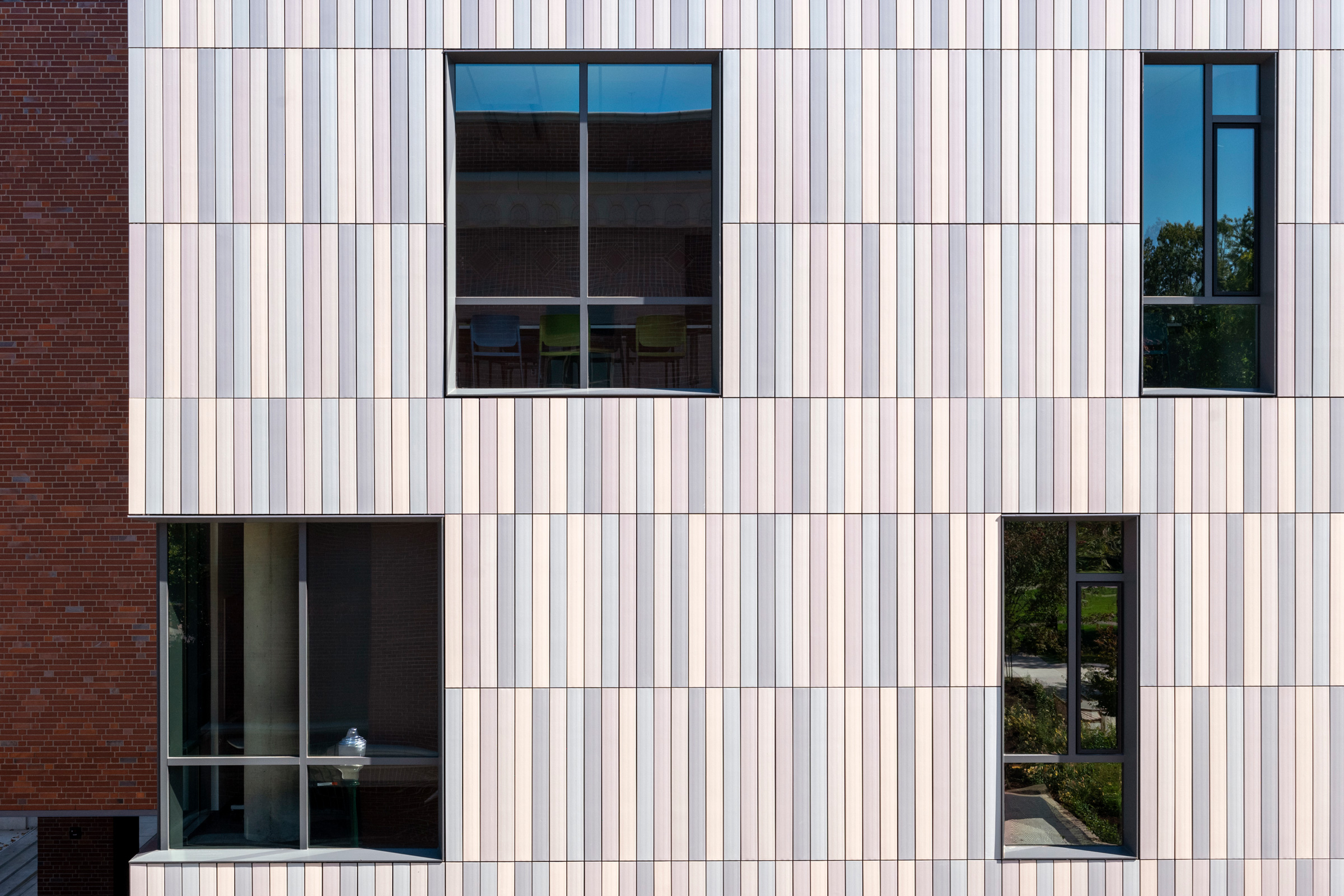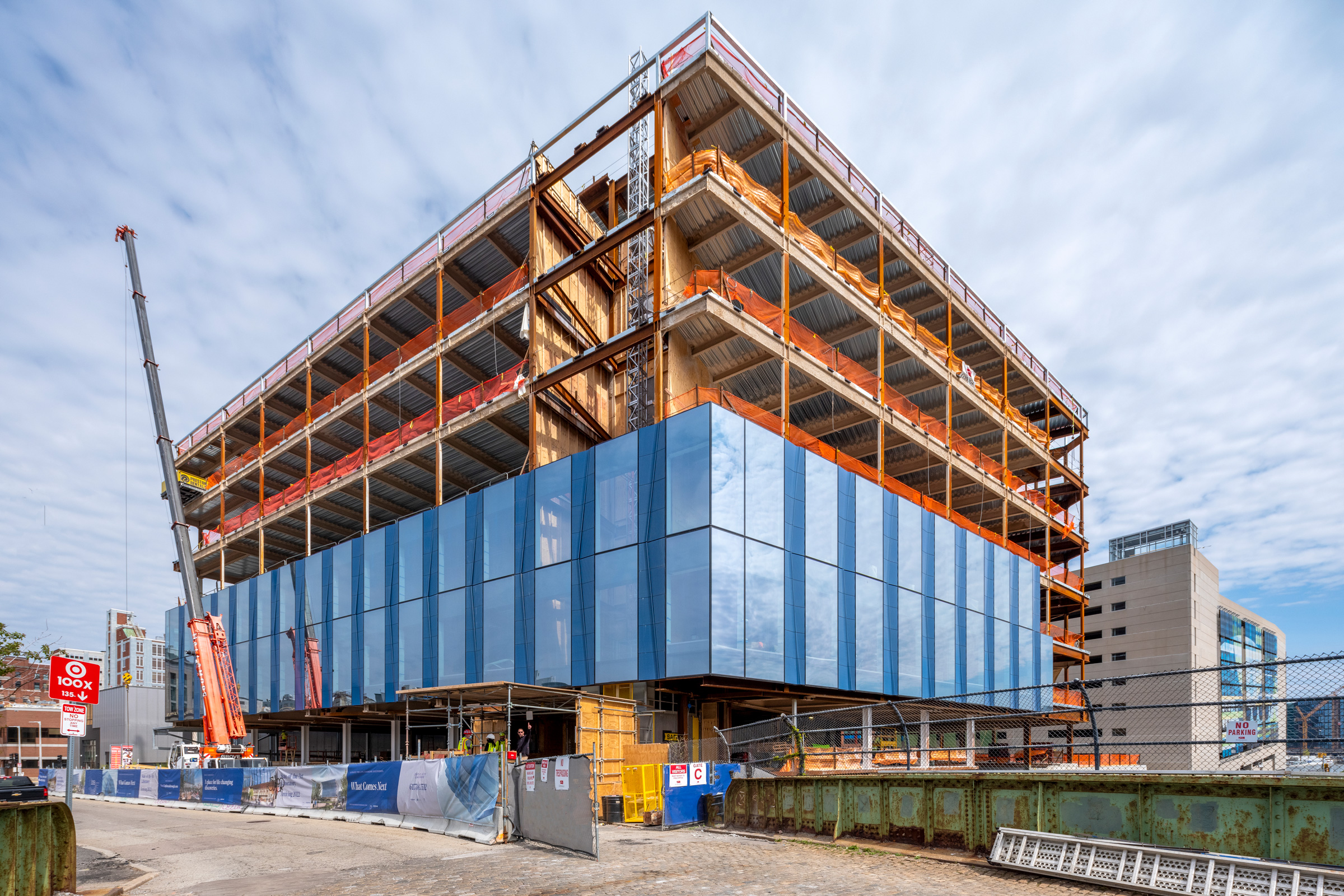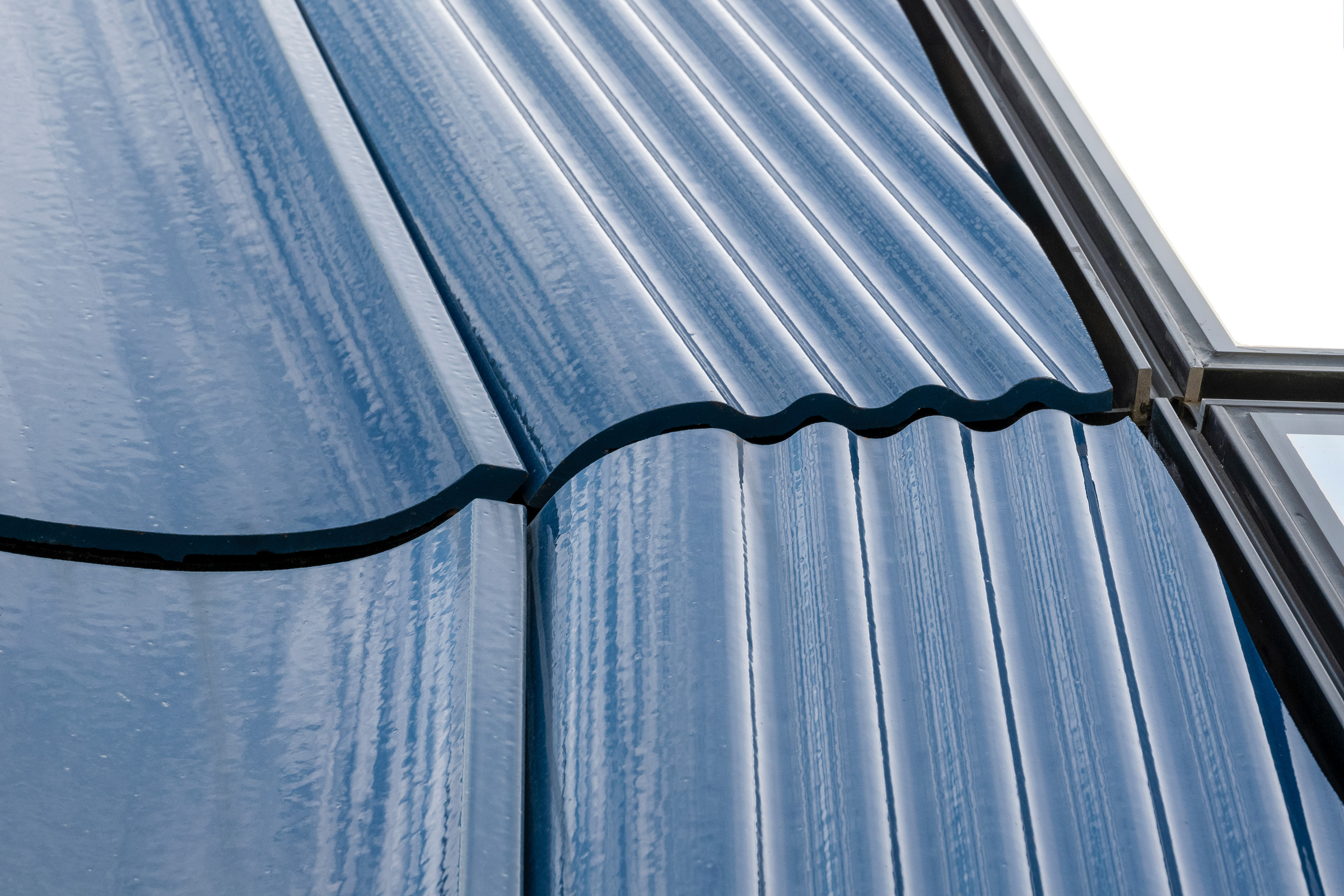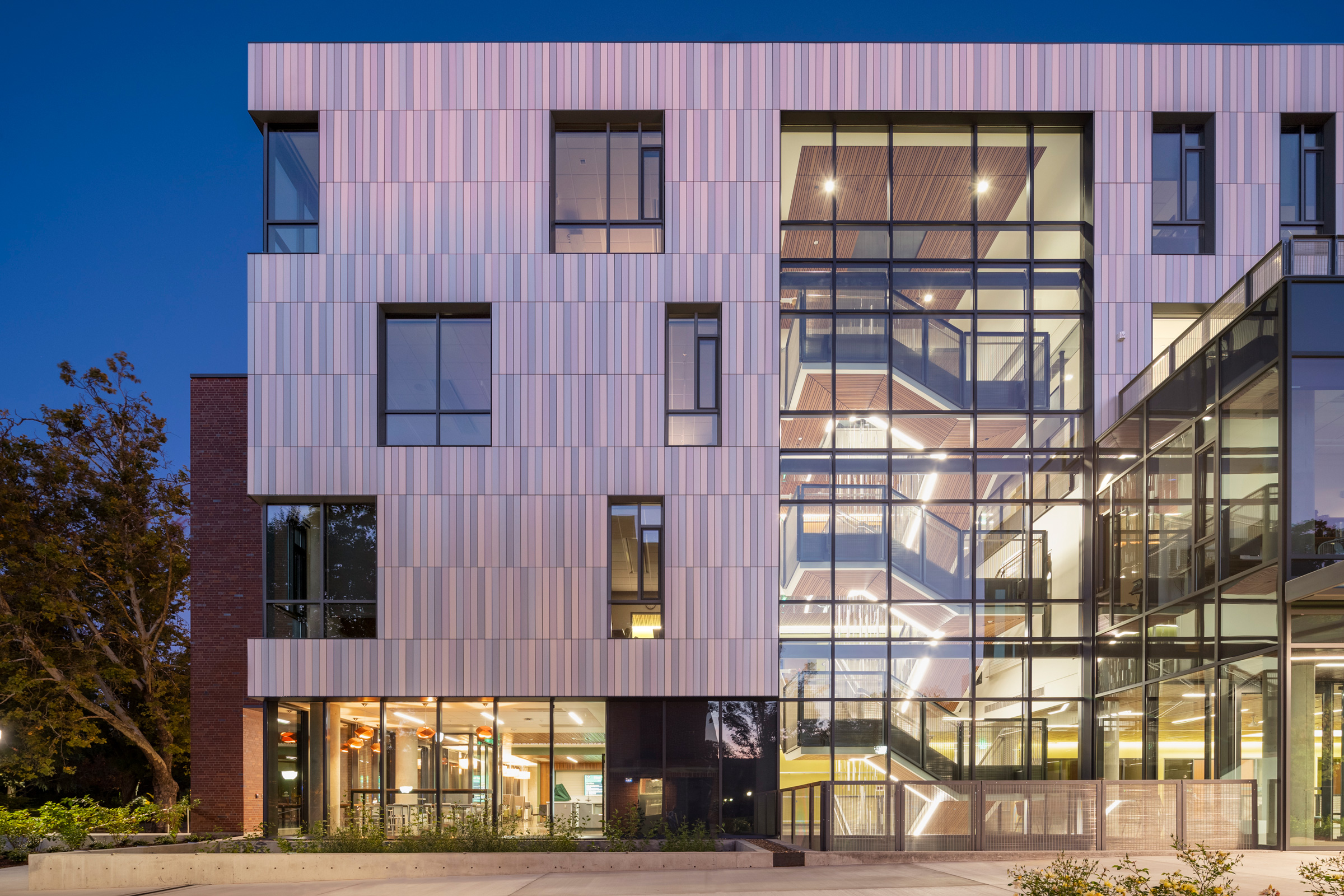Story at a glance:
- Shildan Group innovates with terra-cotta in innovative colors, shapes, and textures.
- Terra-cotta is a natural, sustainable material that can last a lifetime or easily be recycled into another project.
- Projects like The 105 in Boston used terra-cotta in unexpected ways—with blue glazed panels unitized on the curtainwall.
When Moshe Steinmetz, president and founder of leading terra-cotta rainscreen and sunscreen supplier Shildan Group, introduced terra-cotta rainscreen systems to the US market in the late ’90s, rainscreen systems were not widely used in the US. Steinmetz was challenged with convincing architects and contractors to take a chance on open jointed rainscreen systems and explaining this new use of terra-cotta.
“I told them to leave the joint there. You don’t need to caulk or seal it. Leave it open and use terrac-otta to make the facade beautiful and healthy. People looked at me like I was crazy and thought it would never work,” he says, adding that the natural beauty and durability of the terra-cotta and the high performance of the system won out. Now it’s the gold standard.
Since then Shildan Group’s team of engineers, designers, and project managers has worked on more than 450 institutional projects in the US. Designs have evolved from a flat, inch-and-a-half thick red or gray panel to using a variety of shapes, textures, curves, dimensions, and colors. “We are leading by not saying ‘no,’” Steinmetz says. “Architects and designers come to us with intricate designs, complex custom colors, engineering challenges, budget concerns, aggressive schedules, and we don’t say ‘no.’ We find a way to meet challenges as they come and bring design visions to life. We are having fun.”
Advances in design software and 3D printing technology are allowing Shildan Group to do more now than ever before. Steinmetz recently shared some of those innovations with gb&d and explained how terra-cotta is the beautiful and sustainable choice for a building’s facade.
What are the performance benefits of a terra-cotta rainscreen facade system?

Shildan Group worked with Office 52 Architecture on the University of Oregon’s Tykeson Hall. Photo by Sinziana Velicescu
The Shildan/Moeding Terracotta Rainscreen Facade system combines all the benefits of natural terra-cotta with the modern functionality of a rainscreen system. It is an open joint system, allowing air to circulate behind the panels to provide back ventilation and pressure equalization, preventing water from being drawn into the building.
The natural ventilation creates healthy walls, keeping the interior of the building dry and free of mold and mildew. With insulation running outboard of the wall, it reduces overall energy consumption. It performs well even with challenging building conditions, including positive and negative wind loads, seismic, thermal, and normal movement. It also provides acoustic insulation, improving overall comfort and productivity for occupants.
It is a maintenance-free system and a material that should last forever. It doesn’t fade in the sun or change over time. It can be cleaned with water. If necessary, Shildan’s unique rapid clip system allows for the replacement of an individual panel without impacting the surrounding. It is resistant to frost, corrosion, and saltwater. There is no sealing, no mortar to constantly repair. In any material that has caulk joints, you start to see the breakdown over time and need continued maintenance. Terra-cotta is a gorgeous material that lasts forever. Projects built 20 years ago still look like they were built yesterday.
What are the sustainability benefits of using terra-cotta as a building’s facade?
It lasts forever. Terra-cotta is a sustainable, natural material, sourced regionally from the fields around our factory. No CO2 is generated from the raw material itself.
Sustainability is very important to Shildan. Our factory utilizes daylighting, the heat from our kilns is recycled into our drying chambers, and on most productions we push for single firing to minimize the use of energy and our carbon footprint. Our glazes are lead-free and contain pre-consumer recycled material.
High-performing rainscreen systems are also sustainable. Shildan utilizes recycled aluminum, sourced whenever possible within 500 miles of the project site. There are no sealants required. The added insulation of a rainscreen/curtainwall system helps to improve overall thermal performance.
Another part of sustainability that people don’t talk about is the aesthetic context, the beauty. It is so important. Buildings are the heart of our cities, our campuses, our neighborhoods; they connect people to places. Timeless facades influence the architecture of neighborhoods for years to come. Terra-cotta does that. Beautiful is sustainable.
How can terra-cotta bring design visions to life?

Shildan Group worked with Massey, Fabbrica, Breakthrough Properties, Tishman Speyer, Bellco Capital JV, Payette, Consigli Construction Co., and Front on 105 W. First St. in Boston.
Terra-cotta has flexibility in the production method. An architect can design almost anything they want, and Shildan will bring it to fruition. We have many stories of designers and owners coming to us on projects where they’ve been told the designed terra-cotta or systems can’t be achieved. We say, “Let’s work it out and find a solution.” It goes back to having a team of people at Shildan who are creative and willing to think outside of the box. We get excited when we see a new challenge, new shape, custom color, complicated systems, etc. It’s a collaborative process, and we love to roll up our sleeves and find solutions.
An example of this type of collaboration is The 105 in Boston. The architects design showed very large blue glazed panels twisting in a curtainwall unit. Since the panel’s design was twisted, the terra-cotta is diagonal on one dimension and pushed outside the elevation. It was a complex geometric design. After several companies looked at it and said there was no way it could be done in terra-cotta, we took it on. We had two to three weeks to work out an engineering solution for the large complex panels, cutting and coordination with the architect and the curtainwall designer, Fabbrica. The result is gorgeous. We even had an architect who rode past the site during construction. He stopped to ask about the blue glazed panels. He said he had “never seen anything like it and couldn’t believe it was terra-cotta.”
Another recent Shildan project, which achieved LEED Gold and met the Architecture 2030 energy goals, is Tykeson Hall at The University of Oregon. The project by Office 52 Architecture is a case study at the intersection of art and technology. Architect Michelle LaFoe wanted to express the aesthetic connection of the landscapes in the Pacific Northwest and the university campus. LaFoe created a series of oil paintings depicting the colors of the region and turned them into a color palette for the campus. It was a very challenging glaze development since the colors were blends of many different base colors. In the end, after much R&D and collaboration, we were able to match the palette, and the muted tones perfectly capture the essence of the Pacific Northwest and change in tone throughout the day, which was part of the architect’s intent.
The open jointed, back ventilated terra-cotta rainscreen system used on this project offers a high-performing, maintenance-free facade. Using a combination of extruded terra-cotta oriented vertically and marine grade aluminum, the facade will never fade, is frost-resistant, maintenance-free, accommodates high wind loads and seismic activity, has improved thermal performance, and provides a beautiful aesthetic that will last for hundreds of years.
What should architects consider when using terra-cotta as a facade?

105 W First St, Boston. Photo by Sinziana Velicescu
Terra-cotta has evolved over the years. You can do a lot more with it than you think. We like to work with the architect in early design. There are many options and factors that come into play—large-format panels, small-format panels, horizontal versus vertical, deep profile, shadow lines, flat lines, shapes, and so on. We are able to provide technical assistance, design, and give budgeting guidelines. This assures the architect’s design intent is maintained, that the system will perform and can be installed, and that the project budgets are maintained.
There is a perception that terra-cotta is very expensive, but the price has come down over the years. It can be very cost effective when budget is the driving factor. There are many examples of Shildan projects ranging from K-8 schools to government hospitals that have very cost effective designs.
For more customized designs like The 105, Shildan works to optimize terra-cotta dies and systems and finds solutions that keep costs as low as possible. Understanding the design, performance, and budget needs early helps to keep a project on-track. When we work with a new owner or architect, they are usually surprised by the affordability and tell us they wish they had used it on more projects.
What is the design/engineering process like for a project?

105 W First St, Boston. Photo by Sinziana Velicescu
We start with the materials. We test different raw materials for strength, color, acid, and frost resistance and test every new glaze. There are many factors that need to be met at the beginning regarding raw materials. Then we use a lot of technology, like software and 3D printers, to determine how to engineer a specific shape or panel design. We decide on shape, depth, width, length, and other details. Then we think about shipment, how and will the product sustain the trip? We try to catch any potential problems early on.
After that it becomes about the system as a whole. We determine the best system to meet design, safety, and functionality requirements. We discuss the best practices for system design and installation and work out the joints. For a curtainwall on a high-rise, we will add an additional stainless steel clip. Or we might interlock the panels, so if you were to flip the whole system upside down it would stay in place. We offer a training program for installers who have not worked with our product before. We want to think about potential issues and offer solutions throughout the process. We try to think of everything.
Every project has a story, and we are proud to be part of the narrative for so many iconic high-performing facades all over the US and around the world.

